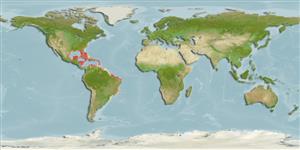>
Gobiiformes (Gobies) >
Gobiidae (Gobies) > Gobiinae
Etymology: Coryphopterus: Greek, koryphe = summit + Greek, pteron = fin, wing (Ref. 45335).
More on author: Gill.
Environment: milieu / climate zone / गहराई सीमा / distribution range
पारिस्थितिकी
समुद्री प्रवाल-भित्ति संयुक्त; गहराई सीमा 2 - 45 m (Ref. 9710). Tropical; 37°N - 33°S
Western Atlantic: North Carolina, USA and Bermuda to Santa Catarina, Brazil (Ref. 57756); throughout the Caribbean Sea.
आकार / वज़न / Age
परिपक्व अवधि: Lm ? range ? - ? cm
Max length : 8.0 cm TL पुल्लिंग / अलिंग; (Ref. 9710)
पृष्ठीय रीढ़ (सम्पूर्ण) : 6; पृष्ठीय सौफट रेज़ (सम्पूर्ण) : 10; गुदा कांटा: 1; ऐनल सौफट रेज़: 10; जानवरों की रीड़ का जोड़: 26. With black spot on side of head above gill cover (Ref. 26938). Individuals from white sand bottom and clear water are pale with two rows of faint yellow spots on side of body; a horizontal orange streak extending posteriorly from middle of eye to above pectoral fin; a row of dusky spots at base of dorsal fins. Individuals from darker bottom and more turbid water are more darkly pigmented; there are 2 rows of dark spots on side of body and one mid-dorsally, fins dusky (Ref. 13442).
Body shape (shape guide): elongated.
Inhabits clear white sandy areas near deep reefs and grassy and rocky areas. Burrows in the sand and the male guards the eggs (Ref. 5521). The Bridled goby, which has X-shaped marks and spots, occurs in both clear and more murky inshore waters, while the paler, very similar Sand goby, Coryphopterus tortugae [= Coryphopterus glaucofraenum], occurs over white sand (Ref. 26938).
Life cycle and mating behavior
परिपक्व अवधि | पुनरुत्पत्ति | मछलीऔ का अंडे देना | अंडे | Fecundity | लार्वा
Oviparous, demersal spawner (Ref. 101194). Both male and female spawn with many individuals in small contiguous territories (Ref. 240).
Robins, C.R. and G.C. Ray, 1986. A field guide to Atlantic coast fishes of North America. Houghton Mifflin Company, Boston, U.S.A. 354 p. (Ref. 7251)
IUCN Red List Status (Ref. 130435: Version 2025-1)
Threat to humans
Harmless
Human uses
मात्स्यिकी: व्यापारिक; जलजीवालय: व्यापारिक
साधन
Special reports
Download XML
इंटरनेट स्रोत
Estimates based on models
Preferred temperature (संदर्भ
123201): 24.4 - 28, mean 27 °C (based on 254 cells).
Phylogenetic diversity index (संदर्भ
82804): PD
50 = 0.5001 [Uniqueness, from 0.5 = low to 2.0 = high].
Bayesian length-weight: a=0.00759 (0.00466 - 0.01235), b=3.04 (2.91 - 3.17), in cm total length, based on LWR estimates for this species & (Sub)family-body (Ref.
93245).
Trophic level (संदर्भ
69278): 2.7 ±0.4 se; based on diet studies.
लौटाव (संदर्भ
120179): ऊंचा, न्यूनतम जनसंख्या दुगनी समय अवलागत 15 महीने। (Preliminary K or Fecundity.).
Fishing Vulnerability (Ref.
59153): Low vulnerability (10 of 100).
🛈
Nutrients (Ref.
124155): Calcium = 166 [74, 326] mg/100g; Iron = 0.879 [0.427, 1.743] mg/100g; Protein = 17.7 [15.7, 19.4] %; Omega3 = 0.0941 [, ] g/100g; Selenium = 28.8 [13.0, 66.9] μg/100g; VitaminA = 115 [28, 450] μg/100g; Zinc = 2.44 [1.56, 3.66] mg/100g (wet weight);
